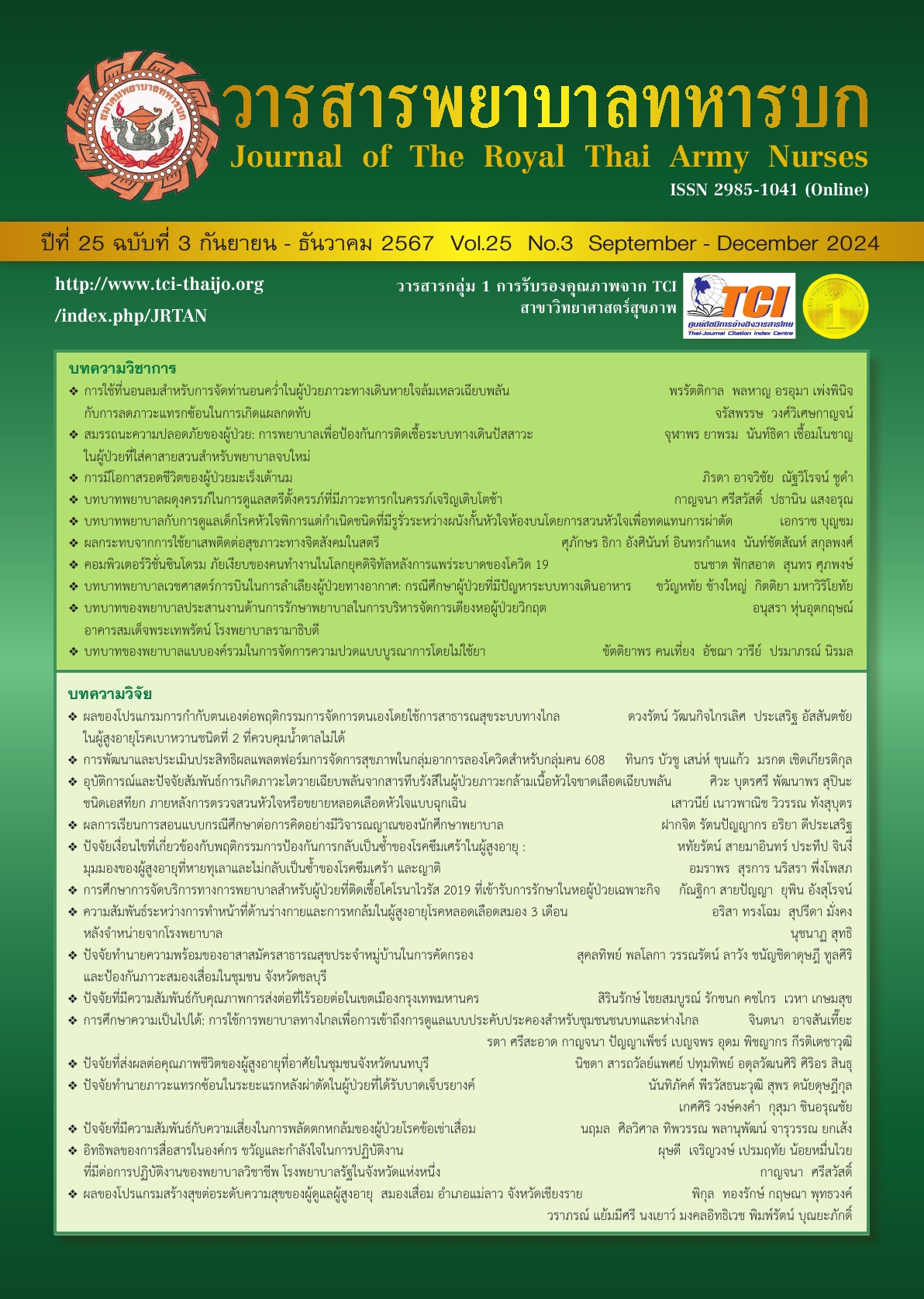Flight Nurse’s Roles in Aeromedical Evacuation: A Case Study of Patients with Gastrointestinal Problems
Keywords:
Aeromedical evacuation, Case study, Nurse’s roles, Flight nurse, Gastrointestinal systemAbstract
Gastrointestinal (GI) disorders can be found in both medical and surgical aspects and the primary causes are correlated to chronic diseases and injuries. When vulnerable GI patients experience life-threatening threats, there could be a high risk of fatality. Aeromedical evacuation is the transportation of patients in both normal and emergency situations, with the aim of transferring them to another facility or hospital to receive proper treatment. The transition of patients at the right time possibly reduces severity and decreases mortality rate. However, barometric pressure changes during the flight directly impact digestive organs, consequently leading to worse conditions and undesirable complications in case of ill treatment. To provide adequate care for GI patients, the flight nurses should be knowledgeable about aviation physiology, stresses of flight, patient assessment, and care procedures before organizing the evacuation and during the flight. Practices of flight nurses should be implemented during aeromedical evacuation to prevent the effects caused by stresses of flight and provide good care along the flight.
Downloads
References
Xu R, Gu Q, Xiao S, Zhao P, & Ding Z. Patientreported gastrointestinal symptoms following surgery for gastric cancer and the relative risk factors. Frontiers in Oncology. 2022.
Tripartite Gastrointestinal Recovery Post-operative IIeus Group. Core outcome set for clinical studies of postoperative ileus after intestinal surgery. British Journal of Surgery. 2022; 109(6):493-6.
Łagosz P, Sokolski M, Biegus J, Tycinska A, & Zymlinski R. Elevated intra-abdominal pressure: a review of current knowledge. World Journal of Clinical Cases. 2022;10(10):3005-13.
Millán M, Ordoñez CA, Parra MW, Caicedo Y, Padilla N, Pino LF, et al. Hemodynamically unstable non-compressible penetrating torso trauma: a practical surgical approach. Colombia Médica. 2021;52(2):e4024592.
Mongkol J, Choocherd S, & Kaukeaw A. Nursing Care for Orthopedic Patients in Aeromedical Evacuation. Journal of The Royal Thai Army Nurses. 2023;24(2):28-35. (in Thai)
National Institute for Emergency Medicine. Emergency aeromedical service guideline health region 1, B.E.2018. Chiangmai: Chiangmai pimniyom limited partnership; 2018. (in Thai)
National Institute for Emergency Medicine. Emergency Aeromedical Service Guideline Revision 2014. Bangkok: Choraka press; 2014. (in Thai)
Institute of Aviation Medicine. Aeromedical Evacuation. Pathum Thani: Thammasat Printing House; 2019. (in Thai)
Khamrath J, Mahaviriyotai K, Ladawan T, & Prabripoo T. Caring of Chest Trauma Patients with Intercostal Drainage: Role of nurses in Aeromedical Evacuation. Journal of The Royal Thai Army Nurses. 2022;23(3):63-9. (in Thai)
Shaw DM, Cabre G, & Gant N. Hypoxic hypoxia and brain function in military aviation: basic physiology and applied perspectives. Frontiers in Physiology. 2021;12:665821.
Collins JA, Rudenski A, Gibson J, Howard L, & O’Driscoll R. Relating oxygen partial pressure, saturation and content: the haemoglobin-oxygen dissociation curve. Breathe. 2015;11(3):194-201.
Hurd WW, & Rothenberg JM. Aeromedical evacuation management of acute and stabilized patients. 2nded. Cham: Springer Nature; 2019.
Leon M, Chavez L, & Surani S. Abdominal compartment syndrome among surgical patients. World Journal of Gastrointestinal Surgery. 2021; 13(4):330-9.
Mazzotta E, Villalobos-Hernandez EC, FiordaDiaz J, Harzman A, & Christofi FL. Postoperative ileus and postoperative gastrointestinal tract dysfunction: pathogenic mechanisms and novel treatment strategies beyond colorectal enhanced recovery after surgery protocols. Frontiers in Pharmacology. 2020;11:583422.
Mo FF, Qin HH, Wang XL, Shen ZL, Xu Z, Wang KH, et al. Acute hyperglycemia is related to gastrointestinal symptoms in motion sickness: an experimental study. Physiology & Behavior. 2012; 105(2):394-401.
Cheung SS. Responses of the hands and feet to cold exposure. Temperature. 2015;2(1):105-20.
Kalemci S, Ergun KE, Kizilay F, Yildiz B, & Simsir A. Analysis of risk factors of abdominal wound dehiscence after radical cystectomy. Revista da Associacao Medica Brasileira. 2022; 68(11):1553-7.
Bagshaw M, & Illig P. The Aircraft Cabin Environment. In: Keystone JS, Kozarsky PE, Connor BA, Nothdurft HD, Mendelson M, Leder K, editors. 4th ed. London: Elsevier; 2019.
Downloads
Published
How to Cite
Issue
Section
License
Copyright (c) 2024 Journal of The Royal Thai Army Nurses

This work is licensed under a Creative Commons Attribution-NonCommercial-NoDerivatives 4.0 International License.
บทความหรือข้อคิดเห็นใดใดที่ปรากฏในวารสารพยาบาลทหารบกเป็นวรรณกรรมของผู้เขียน ซึ่งบรรณาธิการหรือสมาคมพยาบาลทหารบก ไม่จำเป็นต้องเห็นด้วย
บทความที่ได้รับการตีพิมพ์เป็นลิขสิทธิ์ของวารสารพยาบาลทหารบก
The ideas and opinions expressed in the Journal of The Royal Thai Army Nurses are those of the authors and not necessarily those
of the editor or Royal Thai Army Nurses Association.






